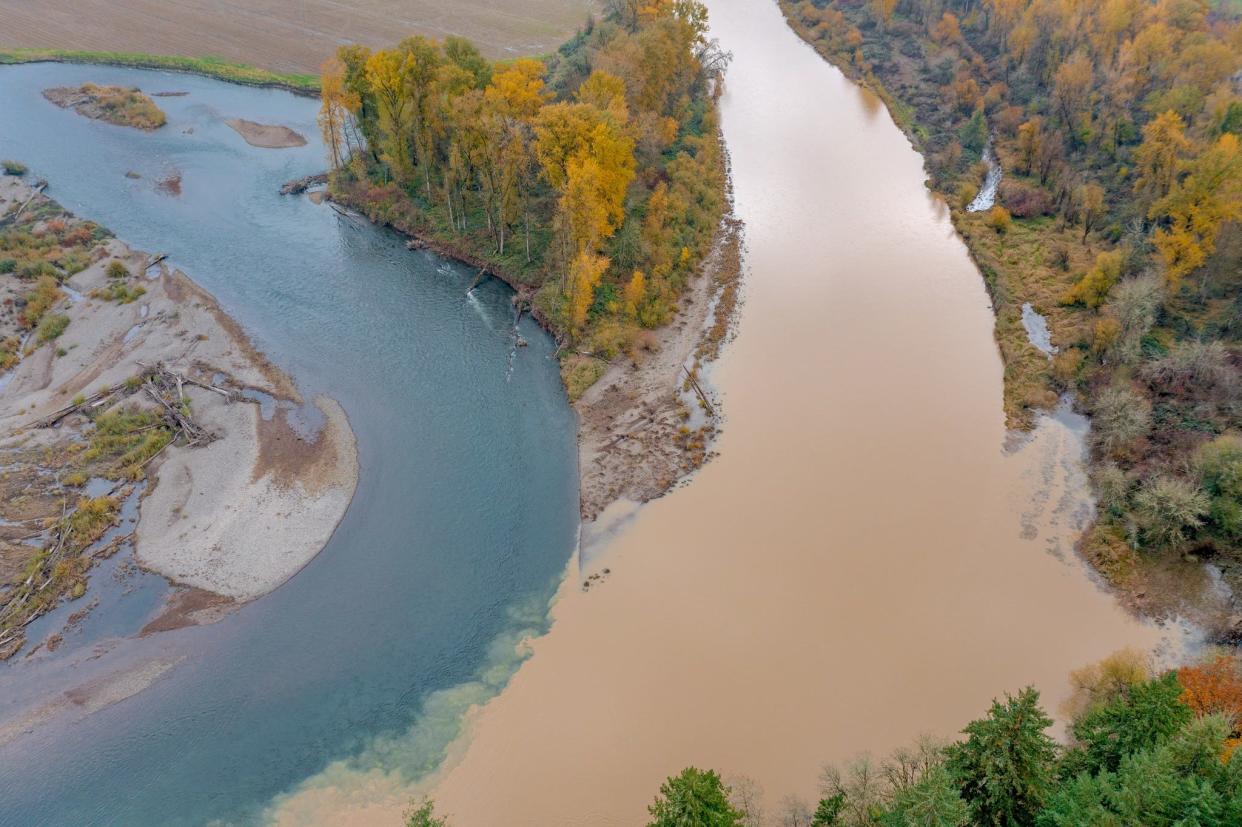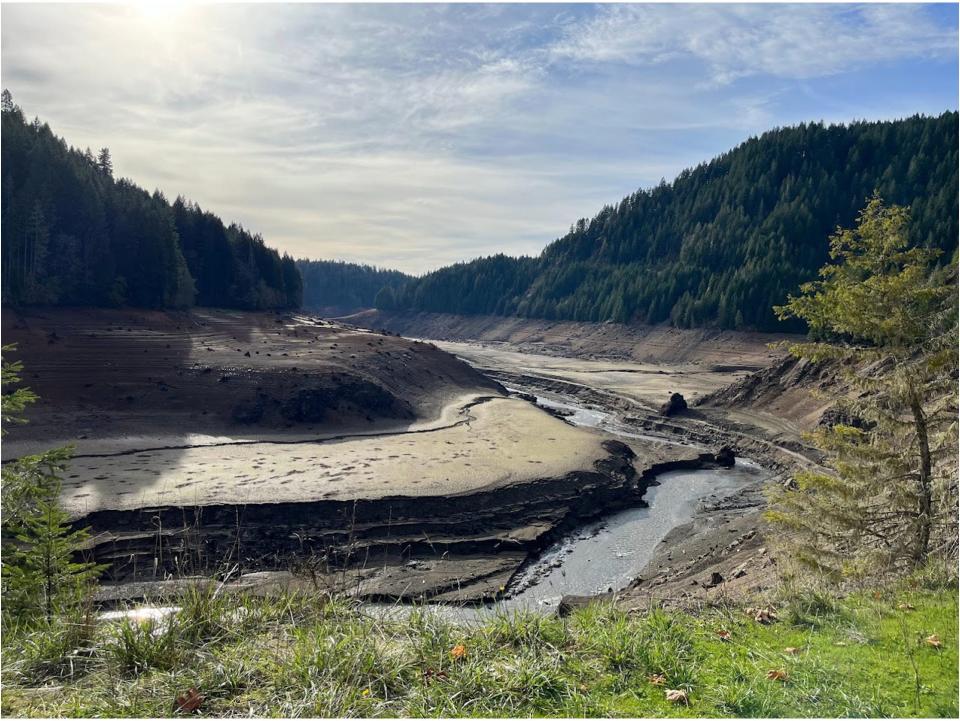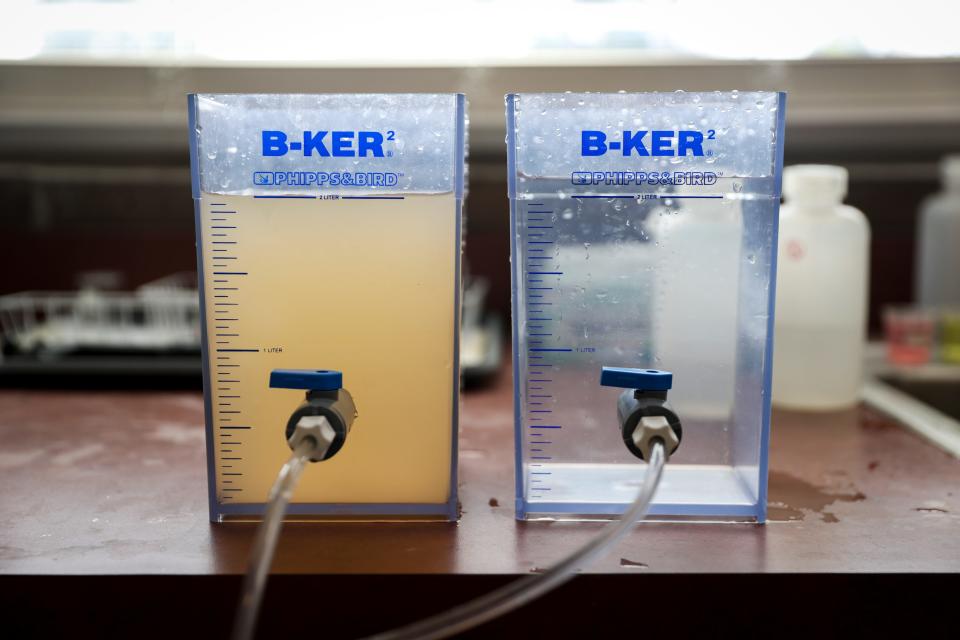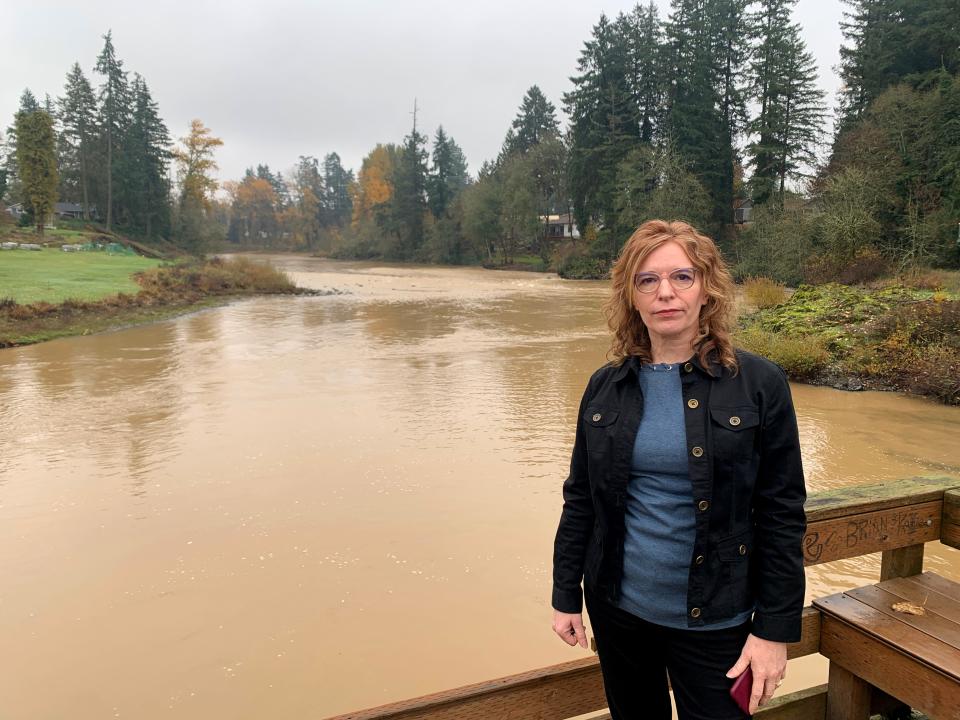Muddy water fix? Corps proposes changes to controversial drawdown of Green Peter Reservoir

The U.S. Army Corps of Engineers is proposing changes to the way it draws down Green Peter Reservoir, hoping to improve conditions for imperiled salmon while avoiding major impacts to city drinking water systems on the South Santiam River.
The federal agency was required to almost empty the reservoir last fall after a court order mandated allowing spring chinook smolts to migrate downstream through Green Peter Dam, with the goal of establishing a wild salmon population above the reservoir.
The move led to masses of built-up sediment being flushed downstream, where it caused millions in damage to the drinking water systems in Sweet Home and Lebanon, harmed tourism and led to the mass die-off of the kokanee population. The turbid and warm water was also bad for salmon, Corps biologists said.
The incident became a flashpoint, with federal, state and local lawmakers — including Gov. Tina Kotek — demanding changes.
The Corps is now taking feedback on its plan from federal and state agencies, along with impacted cities such as Sweet Home, Lebanon and Albany. Then, they'll take the plan to U.S. District Court Judge Marco Hernandez, who ordered the drawdowns in 2021, among a series of actions meant to prevent extinction of Upper Willamette spring Chinook salmon and winter steelhead. Hernandez could rule to allow or deny the modifications, but the Corps is hoping to have the changes in place by this fall.
What is the Corps proposing to do differently?

In a nutshell, the Corps is proposing to delay the time period when it draws the reservoir down and do it faster than a year ago.
Last year, the Corps starting emptying the reservoir in August and reached “low pool” — where the reservoir has essentially been transformed back into a river — in early November. The river stayed there for 30 days to allow spring chinook smolts born in Quartzville Creek, above the reservoir, to migrate downstream to the ocean, in an effort to reestablish a wild salmon population.
This year, the Corps is proposing to empty the reservoir beginning in mid-October and reach low pool in mid-November or early December. It will stay empty for 30 days before being refilled in January.
Tweaked reservoir drawdown better for fish?
The Corps says the later and faster drawdown is good for fish and people.
For fish, the move is better because last year’s drawdown led to high water temperatures in the South Santiam River that likely impacted salmon spawning in the lower river. The muddy water was also likely a problem.
The Corps recorded temperatures in the lower river that reached 60 degrees, which can result in mortality to salmon eggs.
“We saw temperatures spike, and that’s a real problem for salmon spawning in the lower river,” said Greg Taylor, lead fish biologist for the Corps. “We want to safely pass fish through the reservoir, but we don’t want to destroy fish production downstream in doing it. We have to do better with water temperatures. Doing the drawdown later, when the water has cooled more in the reservoir, should help with that.”
Why would the tweaked reservoir drawdown be good for people?

Last year’s drawdown was impactful for numerous reasons in Sweet Home, Lebanon and Albany.
Most notably, the extremely muddy river wreaked havoc on drinking water systems in Sweet Home and Lebanon, causing millions in damage to filters but also requiring adding extra chemicals and having workers going 24/7 to keep the water safe enough for consumption.
The faster drawdown wouldn’t eliminate muddy water, but it would bring it for a shorter period of time, the Corps said.
The later and faster drawdown would also preserve some of the tourism season at Green Peter and Foster lakes, by keeping the lakes full throughout summer and early autumn, which allows for more boating and fishing.
What do local cities think of the plan?

Sweet Home mayor Susan Coleman said she was “grateful” to the Corps for crafting a new plan.
“I am pleased to hear that the drawdown (would) begin later, allowing our community and visitors access to Foster and Green Peter reservoirs throughout the whole summer,” Coleman said in an email. “I appreciate the Corps’ plan to work on keeping the turbidity lower and their commitment to increased communication and coordination with our community."
However, she said muddy water would still impact city drinking water and leave the empty reservoir open to the elements during heavy winter rains. Last year, that led to bank sloughing and further impacted water quality, she said.
“So, although I appreciate the Corps’ adjustments, I am still troubled by the potential of the court mandated drawdown impacting our drinking water,” she said.
What do environmental groups think about the plan?
Three environmental groups brought the lawsuit, under the Federal Endangered Species Act, that led to Judge Hernandez ordering the drawdowns. The groups were the Northwest Environmental Defense Center, WildEarth Guardians and the Native Fish Society. Taylor said they’ll likely need agreement from the groups to make the modifications.
It’s not clear if the groups will agree to the modified drawdown. Mark Sherwood, executive director of the Native Fish Society, said he couldn’t comment on the Corps’ plan. He previously defended the drawdowns and said issues like turbidity would lessen with time.
“If we get fish passage right, we really can restore wild spring chinook in the Willamette — this iconic Oregon fish. That would be a boon for every community in the Willamette Valley,” Sherwood previously told the Statesman Journal.
What happens next?
The Corps will take comments from various groups until July 26. In August, it will submit the modification request to Judge Hernandez. Then, there would likely be a hearing before the request is approved or denied.
What about Lookout Point Reservoir?
Last year, similar issues of muddy water and even dried up wells plagued communities such as Dexter and Lowell downstream of Lookout Point Reservoir during its drawdown. However, no modifications are proposed for that reservoir due to concerns over landslides that will keep the drawdown moving very slowly.
Zach Urness has been an outdoors reporter in Oregon for 16 years and is host of the Explore Oregon Podcast. Urness is the author of “Best Hikes with Kids: Oregon” and “Hiking Southern Oregon.” He can be reached at zurness@StatesmanJournal.com or (503) 399-6801. Find him on X at @ZachsORoutdoors.
This article originally appeared on Salem Statesman Journal: Corps proposes tweaks to drawdown of Green Peter Reservoir

